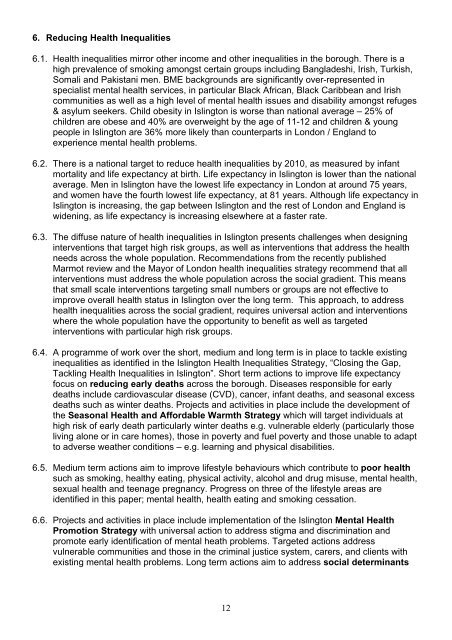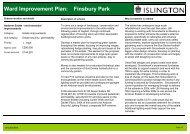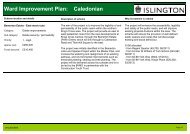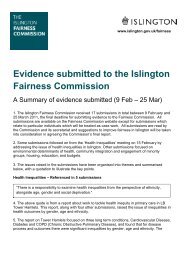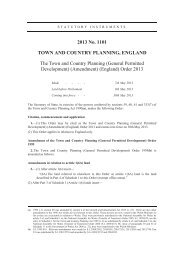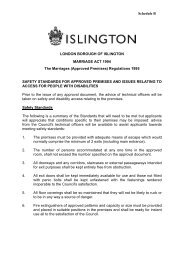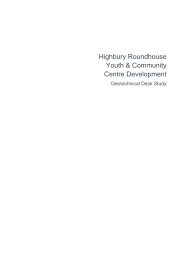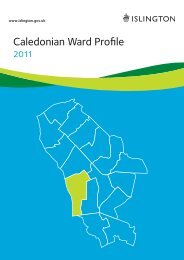Two Islingtons: Understanding the Problem - Islington Council
Two Islingtons: Understanding the Problem - Islington Council
Two Islingtons: Understanding the Problem - Islington Council
You also want an ePaper? Increase the reach of your titles
YUMPU automatically turns print PDFs into web optimized ePapers that Google loves.
6. Reducing Health Inequalities<br />
6.1. Health inequalities mirror o<strong>the</strong>r income and o<strong>the</strong>r inequalities in <strong>the</strong> borough. There is a<br />
high prevalence of smoking amongst certain groups including Bangladeshi, Irish, Turkish,<br />
Somali and Pakistani men. BME backgrounds are significantly over-represented in<br />
specialist mental health services, in particular Black African, Black Caribbean and Irish<br />
communities as well as a high level of mental health issues and disability amongst refuges<br />
& asylum seekers. Child obesity in <strong>Islington</strong> is worse than national average – 25% of<br />
children are obese and 40% are overweight by <strong>the</strong> age of 11-12 and children & young<br />
people in <strong>Islington</strong> are 36% more likely than counterparts in London / England to<br />
experience mental health problems.<br />
6.2. There is a national target to reduce health inequalities by 2010, as measured by infant<br />
mortality and life expectancy at birth. Life expectancy in <strong>Islington</strong> is lower than <strong>the</strong> national<br />
average. Men in <strong>Islington</strong> have <strong>the</strong> lowest life expectancy in London at around 75 years,<br />
and women have <strong>the</strong> fourth lowest life expectancy, at 81 years. Although life expectancy in<br />
<strong>Islington</strong> is increasing, <strong>the</strong> gap between <strong>Islington</strong> and <strong>the</strong> rest of London and England is<br />
widening, as life expectancy is increasing elsewhere at a faster rate.<br />
6.3. The diffuse nature of health inequalities in <strong>Islington</strong> presents challenges when designing<br />
interventions that target high risk groups, as well as interventions that address <strong>the</strong> health<br />
needs across <strong>the</strong> whole population. Recommendations from <strong>the</strong> recently published<br />
Marmot review and <strong>the</strong> Mayor of London health inequalities strategy recommend that all<br />
interventions must address <strong>the</strong> whole population across <strong>the</strong> social gradient. This means<br />
that small scale interventions targeting small numbers or groups are not effective to<br />
improve overall health status in <strong>Islington</strong> over <strong>the</strong> long term. This approach, to address<br />
health inequalities across <strong>the</strong> social gradient, requires universal action and interventions<br />
where <strong>the</strong> whole population have <strong>the</strong> opportunity to benefit as well as targeted<br />
interventions with particular high risk groups.<br />
6.4. A programme of work over <strong>the</strong> short, medium and long term is in place to tackle existing<br />
inequalities as identified in <strong>the</strong> <strong>Islington</strong> Health Inequalities Strategy, “Closing <strong>the</strong> Gap,<br />
Tackling Health Inequalities in <strong>Islington</strong>”. Short term actions to improve life expectancy<br />
focus on reducing early deaths across <strong>the</strong> borough. Diseases responsible for early<br />
deaths include cardiovascular disease (CVD), cancer, infant deaths, and seasonal excess<br />
deaths such as winter deaths. Projects and activities in place include <strong>the</strong> development of<br />
<strong>the</strong> Seasonal Health and Affordable Warmth Strategy which will target individuals at<br />
high risk of early death particularly winter deaths e.g. vulnerable elderly (particularly those<br />
living alone or in care homes), those in poverty and fuel poverty and those unable to adapt<br />
to adverse wea<strong>the</strong>r conditions – e.g. learning and physical disabilities.<br />
6.5. Medium term actions aim to improve lifestyle behaviours which contribute to poor health<br />
such as smoking, healthy eating, physical activity, alcohol and drug misuse, mental health,<br />
sexual health and teenage pregnancy. Progress on three of <strong>the</strong> lifestyle areas are<br />
identified in this paper; mental health, health eating and smoking cessation.<br />
6.6. Projects and activities in place include implementation of <strong>the</strong> <strong>Islington</strong> Mental Health<br />
Promotion Strategy with universal action to address stigma and discrimination and<br />
promote early identification of mental heath problems. Targeted actions address<br />
vulnerable communities and those in <strong>the</strong> criminal justice system, carers, and clients with<br />
existing mental health problems. Long term actions aim to address social determinants<br />
12


